Anderson, A. D., Hunt, A. N., Powell, R. E., & Dollar, C. B. (2013). Student perceptions of teaching transparency. Journal of Effective Teaching, 13(2), 38-47.
Bensimon, E. M. (2012). The equity scorecard: Theory of change. Confronting equity issues on campus: Implementing the equity scorecard in theory and practice, 17-44.
Bensimon, E. M., Dowd, A. C., & Witham, K. (2016). Five principles for enacting equity by design. Diversity and Democracy, 19(1), 1-8.
Brookfield, S. (2015). So what exactly is critical about critical reflection?. In Researching critical reflection (pp. 11-22). Routledge.
Castillo‐Montoya, M. (2018). Rigor revisited: Scaffolding college student learning by incorporating their lived experiences. New Directions for Higher Education, 2018(181), 37-46.
Copeland, D. E., Winkelmes, M. A., & Gunawan, K. R. I. S. (2018). Helping students by using transparent writing assignments. Integrating writing into the psychology course: Strategies for promoting student success, 26-37.
Deslauriers, L., McCarty, L. S., Miller, K., Callaghan, K., & Kestin, G. (2019). Measuring actual learning versus feeling of learning in response to being actively engaged in the classroom. Proceedings of the National Academy of Sciences, 116(39), 19251-19257.
Ives, J., & Castillo-Montoya, M. (2020). First-generation college students as academic learners: A systematic review. Review of Educational Research, 90(2), 139-178.
Jehangir, R. (2010). Stories as knowledge: Bringing the lived experience of first-generation college students into the academy. Urban Education, 45(4), 533-553.
Karp, M. M. (2011). Toward a New Understanding of Non-Academic Student Support: Four Mechanisms Encouraging Positive Student Outcomes in the Community College. CCRC Working Paper No. 28. Assessment of Evidence Series. Community College Research Center, Columbia University.
Kishimoto, K. (2018). Anti-racist pedagogy: From faculty’s self-reflection to organizing within and beyond the classroom. Race Ethnicity and Education, 21(4), 540-554.
Kozanitis, A., & Nenciovici, L. (2023). Effect of active learning versus traditional lecturing on the learning achievement of college students in humanities and social sciences: A meta-analysis. Higher Education, 86(6), 1377-1394.
Lee, E., & Hannafin, M. J. (2016). A design framework for enhancing engagement in student-centered learning: Own it, learn it, and share it. Educational technology research and development, 64(4), 707-734.
McCallen, L. S., & Johnson, H. L. (2020). The role of institutional agents in promoting higher education success among first-generation college students at a public urban university. Journal of Diversity in Higher Education, 13(4), 320.
Museus, S. D., & Chang, T. H. (2021). The impact of campus environments on sense of belonging for first-generation college students. Journal of College Student Development, 62(3), 367-372.
Orón Semper, J. V., & Blasco, M. (2018). Revealing the hidden curriculum in higher education. Studies in Philosophy and Education, 37, 481-498.
St-Amand, J., Girard, S., & Smith, J. (2017). Sense of belonging at school: Defining attributes, determinants, and sustaining strategies.
Waks, L. J. (2018). Humility in teaching. Educational Theory, 68(4-5), 427-442.
Winkelmes, M. A., Boye, A., & Tapp, S. (Eds.). (2023). Transparent design in higher education teaching and leadership: A guide to implementing the transparency framework institution-wide to improve learning and retention. Taylor & Francis.
Yosso, T. J. (2002). Toward a critical race curriculum. Equity & Excellence in Education, 35(2), 93–107. https://doi.org/10.1080/713845283
Yosso, T. J. (2005). Whose culture has capital? A critical race theory discussion of community cultural wealth. Race Ethnicity and Education, 8(1), 69–91.

